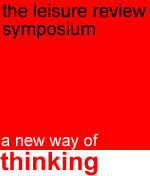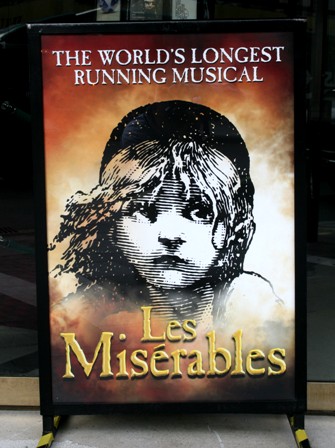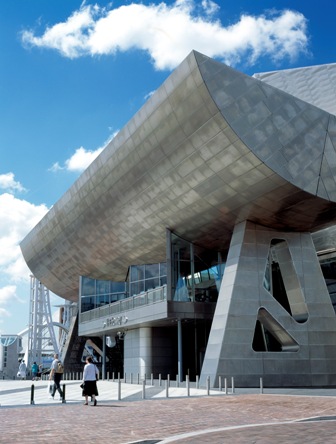
Mister Lowry, meet Monsieur Hugo
In April the Lowry in Manchester celebrated its tenth anniversary and launched a diverse season of events and exhibitions. Under the guise of a visit to see the penultimate performance of the Les Miserables national tour Mick Owen went to see how the venue was developing.
Ask the man on the Eccles tram what goes on at Salford Quays and he could talk about football, shopping or “a wonderful mix of culture, retail and leisure around a continually evolving waterfront destination”, if the man you asked happened to be the copy writer for the Quays website. In a month when we learned that 1.8% of England’s workforce is employed in “sport” it might be politic to add that pastime to the marketing mix, especially given the proximity of Manchester United’s hypermarket of dreams and the fact that triathlon has brought world cup races and the Commonwealth Games event to the former docks area. Or, if the politics demand a more egalitarian approach, the sales team could point to the open-water swimming sessions being advertised for every Saturday morning between May and October or the water sports centre owned by Salford City Council, currently offering everything waterborne from windsurfing to wow balls, whatever they may be.
However, focusing on the sport bit of the sport, leisure and culture offer at Salford Quays would be an error, not least because sport is a minor player. The arts dominate the Quays cultural scene, along with that most common of leisure pursuits, shopping. The Lowry building, designed by James Stirling and Michael Wilford, is a wonderfully unique statement. Built at the end of Pier 8 of the docks that once linked the Manchester conurbation with the world, the building sits where the Manchester Ship Canal met the roads, rails and canals of the interior in a welter of warehouses, wharves and tracts of still, dark water. The Lowry docks the past to the future. Its mass is created from a giant child’s building blocks, geometric shapes placed, if you stand on the far canal bank, to look like a Cunard liner moored nose-on to the jutting promontory of the old quay. Across a plaza, which was filled in April by naked bodies as part of Spencer Tunick’s Everyday People installation, the coupling is complacently accepted by the other Lowry centre, a double-decked shopping centre flogging end-of-line and out-of-fashion tat to diminishing numbers of low-rent retail-experience consumers. And rising above, beyond and around the cut-price mall are blocks of accommodation units for the over-paid and overly self-impressed. The BBC’s decision to relocate wholesale to Media City, a stroll across a dock from the Lowry, has brought salvation to the Quays’ estate agencies, with King Sturges going to the extent of acquiring a strategically placed Portacabin bedecked with the Media City logo from which to retail its aspirations. There is a zing to the zeitgeist down by the docks however reticent the London mediarati are to embrace it.
Despite the tawdry efforts of the chain-store marketeers, there is sufficient authenticity in and around the Quays area to combat the cheapening and homogenisation that so bedevils community spaces where commercialism holds sway. Daniel Libeskind’s brooding Imperial War Museum North set apart over the canal, the shimmering, copper, Aztec pyramid of the Quay West building, and the vitality and innovation that virtually pours from The Lowry itself combine to create a wholesome positive. The contradictions of the space are matched by the experience as high art, such as Opera North’s Carmen, rubs along with an “affectionate romp through 50 dramatic years” of Coronation Street in the theatre while the various exhibition spaces host everything from Leo Fitzmaurice’s “extraordinary installation that turns the gallery walls into oversized packaging boxes” to the rather cosier Meet Mr Lowry film running on a 20-minute loop in its own little pod. And on all sides people seek to sell mass-produced products and experiences.
Either side of the plaza the contradictions continue with the warehouse-restaurant Café Rouge offering corporate Gallic décor (if such a thing exists) and a kitchen which forgets the potatoes and the anchovies in saumon à la nicoises. Fakery and lack of attention to culinary detail are surely the expectation in a restaurant franchise located in a Salford shopping centre so to discover French waiting-on staff in the mise-en-scène is doubly surprising. To be impatiently flounced at and haughtily patronised in the authentic French manner in a room as redolent of Paris as the café in ‘Allo ‘Allo is of the same order of surprise as discovering that Victor Hugo’s seminal work on retribution and revolution had been turned into a musical that is currently in its twenty-fifth year. But at the Lowry, it seems, all things are possible.
Depending on who you listen to, Cameron Mackintosh is an impresario of genius, a knight of the realm, “the most successful, influential and powerful theatrical producer in the world” or a limited company. In this last role he will have three productions of Les Miserables running in October in London alone. If the production was what we have learned to call “a feel-good experience” this joyous celebration of all things Boublil and Schönberg, the people who actually forced Hugo’s quart of a novel into the pint-pot format of a stage musical, might be explicable but the truth is that the highlights of the production are a pitched battle in which virtually all the good guys die and the suicide of a policeman who represents ‘the law’. The plot also covers slavery, child abuse, forced prostitution (is there any other kind?), disease, destructive obsession, brutal poverty, the death of a generation and the futility of the human condition. With all of this painted against a backdrop that uses every shade of colour from light grey to dark grey and a set that, when its stays still long enough, is brutally asymmetric the wonder is that anyone returns after the interval, which comes after some 90 minutes of despair layered on despite. It is not as if there are a host of good tunes to get your foot tapping.
Return they do, however, in their droves. Not just after the interval but again and again. “Les Mis”, as the aficionado delights in styling the show, is one of the hottest tickets in the theatrical world. The knowledgeable start the standing ovation before the last sung note dies and the curtain call adds a further five minutes to what is a remarkable coup de theatre. Musical noir must be considered a tiny niche but seeing Mackintosh as Frankenstein complete with monster is inaccurate. The plot is byzantine, the themes immense; the music swells and rolls like a storm at sea and the stage effects dwarf the players. But the singing – and every word is sung – is wonderful. The despondent braggadocio of the themes, set and score are heroically rescued by the reach and quality of the singing from principals, supporting cast and swings alike. Even the sprinkling of reality-show rejects that must now pepper every music-based offering in our theatres can carry a tune. Their combined output stretched over three hours and this, backed by a note-perfect orchestra pit, brings its own redemption. It is fantastic.
Architecture like the Lowry and its neighbours, theatre like Les Miserables and indeed the primitive daubings of LS Lowry himself force the consumer to choose. There are no easy answers to the question, “Is this good art?”. The Lowry looks like a child’s attempt at design, especially its internal spaces, Les Miserables is all too well named and Mr Lowry paints stick people; but all of them stir and challenge. Throw in a haughty French waitress and a breezy walk in the sun and even Monsieur Hugo might have cracked a smile.
Mick Owen is managing editor and theatre critic of The Leisure Review.
The Leisure Review, September 2010
© Copyright of all material on this site is retained by The Leisure Review or the individual contributors where stated. Contact The Leisure Review for details.
Download a pdf version of this article for printing

